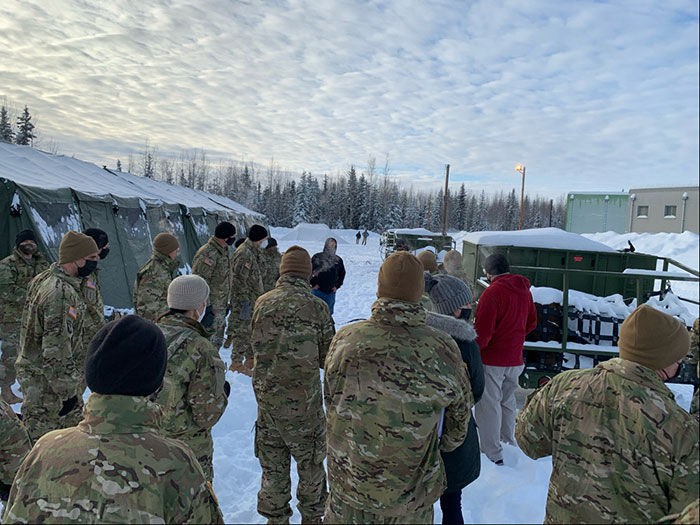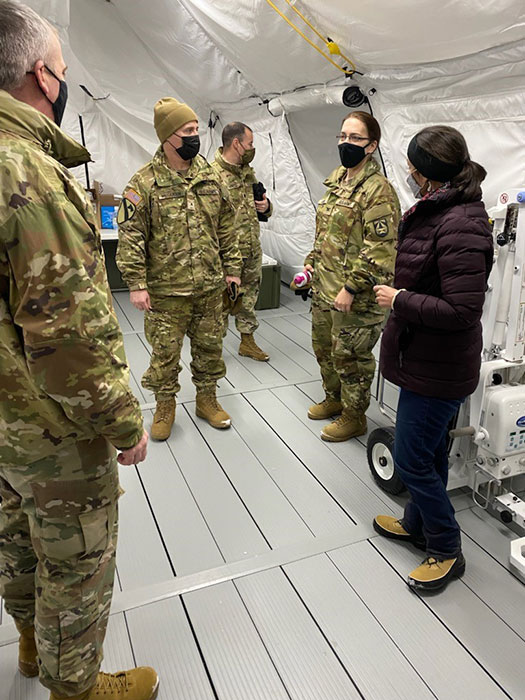In the Arctic, USAMMDA Charts Course for Army Dominance

Service Members with the U.S. Army Medical Research and Development Command's U.S. Army Medical Materiel Development Activity return home this week following a 10-day Arctic Field Hospital Experiment at Ft. Wainwright, in Alaska. The exercise, which focused primarily on the Army's ability to construct a Role 3 medical treatment facility in sub-freezing temperatures, is part of the Army's ongoing efforts to expand its capabilities in the Arctic; an arena of competition increasingly vital to the security of the Nation.
"This is a great first step towards re-imagining how we'll provide medical capabilities to care for Warfighters who may need to deploy into arctic environments," said USAMMDA Commander Col. Gina Adam. "Providing medical care in an extreme cold weather environment will require new ways of thinking about doctrine, tactics, training and materiel solutions."
During the event, USAMMDA evaluated the structural integrity and working capacity of a 12-bed field hospital in an Arctic environment that, according to onsite personnel, dipped to as low as 31 degrees below zero at times. The exercise also included the evaluation of 24 individual pieces of medical equipment, including patient monitors and sterilizers. Notable among the larger pieces of infrastructure slated for testing were standard Base-X tents and accompanying IASH-II tent heaters; each critically important to the mission, with the latter ultimately providing a consistent temperature of 65 degrees or more inside the tents themselves – a temperature deemed suitable for patient care.
According to USAMMDA personnel, nearly all medical equipment passed safety, performance and operational checks when compared to baseline readings after both 48 hours of cold storage and, later, a 48 hour re-warming effort prior to operation. According to USAMMDA project managers, several pieces of medical equipment were intentionally frozen prior to use in order to determine feasibility in harsh conditions.

"We really wanted to push the equipment in this kind of hard environment," said Col. Norman Waters, chief of systems integration at USAMMDA and a key organizer of the event. "If you can't get the infrastructure piece correct, then everything else doesn't matter; you can't get medical equipment in there, you can't get personnel in there to perform proper medical care."
Overall, the effort is designed to buttress U.S. Department of Defense efforts to assert dominance in the region. According to the Arctic strategy document released last year, the Army has been charged directly with ensuring the "materiel readiness" of Arctic-capable units in order to improve extended operations in the region. That means developing and testing everything from machinery and weaponry to items as simple as the latex gloves used by medical staff to treat patients. As such, improving medical capabilities is essential to the overall effort in the region.
"USAMMDA's recent exercise in Alaska is a tangible demonstration of our enduring commitment to the medical care and comfort of Warfighters stationed in such climates," said Brig. Gen. Anthony McQueen, commanding general of USAMRDC and Fort Detrick, Maryland. "The Army's efforts to expand upon our current capabilities in the Arctic presents a unique challenge – one that MRDC is certainly capable of meeting."
In addition to the overall success of the exercise, USAMMDA personnel note that none of the 16 participating Service Members recorded any cold weather injuries, a nod to the benefits of the assembled training plan.
The event itself was conducted from February 12-22, alongside partner organizations U.S. Army Alaska, 18th MEDCOM and the 147th Field Hospital Unit. Both USAMMDA and the Medical Capability Development Integration Directorate will develop and then share event analysis and future concept development reports in the coming months. A similar training exercise is scheduled to take place next year.
"This is the first time that we put it all together; put the generators together with the heaters, put the tents together, put together a hospital and tested it as a system," said Waters, applauding the teamwork required to both plan and execute the event. "This exercise was really just the first phase of data collecting."














